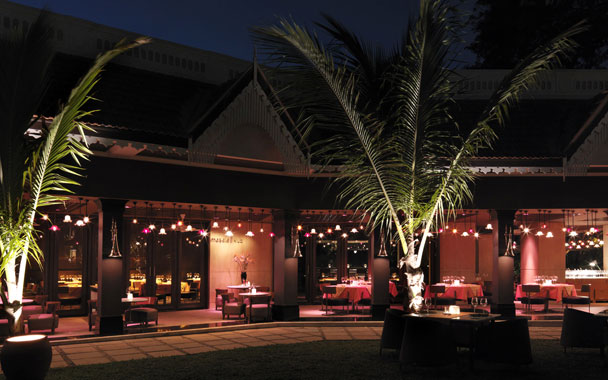
Recently, I dined at Masala Klub, a new upscale Indian restaurant at the Taj West End hotel in Bangalore. I went with my mother, mostly because my husband refused to go. (“I wouldn’t eat at a restaurant that spells its name ‘klub’ if you paid me,” he said haughtily.) She likes to eat out, and has traveled abroad, but like most mothers, mine has embarrassed me to no end: In New York, for example, she sent back a fine black truffle risotto at San Domenico saying that the rice was undercooked. She is fiercely opinionated about Indian cuisine, so I was interested to see how this meal would turn out.
At Masala Klub, Mom was all smiles as she sipped the white wine. The first course was a lemongrass rasam. Uh-oh, I thought. Rasam is the holy grail of our community, the Tamil Brahmin people. It’s like chicken soup—comfort food that every home chef, mother, and grandmother takes pride in. Surprisingly, we both liked it. Then came the main course, a beautifully styled square plate. There was paneer (“too chewy,” Mom said, and I had to agree); spiced haricots verts (“undercooked,” she said, but I didn’t agree this time); and a couple of other forgettable dishes. Nothing surprised or titillated. The “wow” factor was absent.
The chef, Hemant Oberoi, a genial, hail-fellow-well-met type, came out to greet diners. He has traveled the globe and knows many of the world’s top chefs. For a while, he and I jousted, dropping names like a pair of seasoned wrestlers. “Fat Duck?” I asked. “Been there,” he said. “Met up with Alain Ducasse in Monte Carlo,” he said. “What about Adrià?” I asked. “Not yet,” he replied. “Loved Per Se,” he said. “How about Alinea?” I asked. “No, but loved Charlie Trotter.” After a while, I gave up to concentrate on my masala chai ice cream.
Oberoi is clearly savvy and well-traveled. He knows food and hobnobs with the world’s best chefs. Then why, I thought, couldn’t he summon up an Indian meal to astonish Mom and me?
I realized that I already knew the answer. Opening an Indian restaurant in India isn’t easy, particularly if you’re going for haute cuisine and pan-regional tastes. Indians, like my mother, are famously possessive about their food; they have strong opinions about how each dish ought to be cooked, and they aren’t afraid to voice them. Mom, for instance, hates the whole notion of garam masala, that spice mixture beloved to North Indians. To her, it’s spice overload. She’d much rather adjust the heat and tartness of a dish judiciously, using fresh herbs like cilantro or a single green chili. My aunt, on the other hand, swears by garam masala, which she insists rounds off a dish nicely. (At family reunions, one of our main goals is to make sure that these two women never cook side by side.)
Any chef in India also faces severe repercussions from the Authenticity Police, of which my husband, Ram, is a card-carrying member. It’s not that he isn’t adventurous, but when it comes to Indian food, he becomes impossibly proprietorial: “Why mess with recipes that are thousands of years old?” is his attitude. He views all fusion food with deep suspicion; mix tamarind and tamari and he’ll practically froth at the mouth. The problem for inventive young Indian chefs working in India is that diners like Ram are not the minority. Change the tempering in a sauce or the texture of a curry and the Authenticity Police will rise in arms. Woe betides anyone who dares to experiment with a beloved dal makhni recipe or even a simple raita.
And then there’s the problem of spice. Although spicy, piquant ingredients like chiles, fenugreek, and asifoetida are fundamental to Indian food, there are regional variations in people’s tolerance to them. A dish that would be bland for a South Indian palate will have the Kashmiri sweating buckets. Modern Indian restaurants that serve pan-Indian food have to factor that in. Bhima’s is a popular restaurant in Bangalore that serves unabashedly fiery Andhra food and attracts only those that can handle the spiciness. My brother loves it. My husband, after 20 years in the U.S., would have to opt for a Greek salad.
And what about me? When I go to a place like Craft, I go with an open mind. But the minute I set foot in an Indian restaurant, I expect the food to fall within certain parameters. It has to taste “Indian.” In the end, I am no different from my mother. But I have a solution: A genius of a chef who can change the paradigm. It would confuse us to no end, rendering us too taste-struck to complain.
Changing the paradigm involves a couple of things: creativity of course, but also consistency and patience. When Suvir Saran and Floyd Cardoz, for example, push the envelope with Indian food in the United States, even adventurous eaters (such as myself) balk a bit because we feel that we own certain foods, and we cannot bear it if they are tampered with. The same is true with many other Indian diners, who have their own specific taste memory for Indian food. Avant-garde chefs have to do two things: They have to “wow” diners who are unfamiliar with the spices, introducing them to Indian food and at the other end of the spectrum, they have to coax Indians into accepting the changes they make with beloved dishes.





Leave A Comment